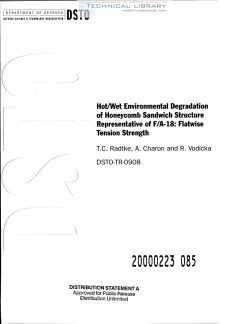DSTO-TR-0908 Hot or Wet Degradation of HoneycombSandwich Structure Representation of F A18 Flatwise Tension Strength

- Version
- 70 Downloads
- 2.09 MB File Size
- 1 File Count
- May 16, 2020 Create Date
- May 16, 2020 Last Updated
Aluminium honeycomb structure is widely used in the F/A-18 to save weight, however it is susceptible to degradation by water. The US Navy has experienced in-flight failures of honeycomb components such as the rudder which are believed to be due to moisture induced degradation. A long-term (52 week) environmental exposure trial was conducted to determine the effects on the flatwise tension (FWT) strength of honeycomb sandwich structure. A conditioning temperature of 70°C was chosen coupled with high-humidity exposure (85% and 95% R.H) to simulate a worst-case hot/wet environment. The trial simulated specimens in which moisture could freely enter the core (direct ingress) and those which were fully sealed and allowed only moisture diffusion through the epoxy matrix of the skins (diffusion ingress). The FWT strength was measured at 4, 9,16, 32 and 52 weeks exposure. The FWT values decreased by about 40-50% when tested at 104°C and about 25% when tested at room temperature after exposure periods greater than 16 weeks. Both the direct ingress and diffusion ingress samples showed similar FWT strength losses but markedly different modes of failure. Diffusion specimens failed cohesively in all cases while the direct ingress samples failed predominantly adhesively after an exposure time of about 9 weeks. Subsequent drying of the samples exposed to the conditioning environment showed that diffusion ingress samples recovered most of their original FWT strength but direct ingress samples recovered only about 70% of their original baseline strength. This work shows that excluding water from within honeycomb sandwich structures is of primary importance in order to prevent permanent bond degradation and corrosion of the core.
| File | Action |
|---|---|
| DSTO-TR-0908 Hot or Wet Degradation of HoneycombSandwich Structure Representation of F A18 Flatwise Tension Strength.pdf | Download |

Comment On This Post